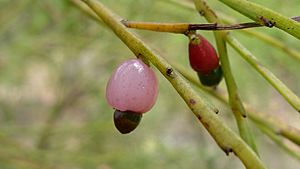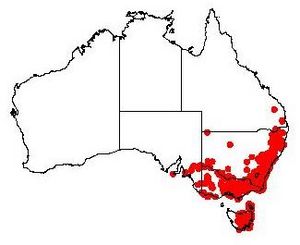Exocarpos strictus facts for kids
Quick facts for kids Exocarpos strictus |
|
|---|---|
 |
|
| Scientific classification | |
| Genus: |
Exocarpos
|
| Species: |
strictus
|
 |
|
| Occurrence data from AVH | |
Exocarpos strictus, also known as pale-fruit ballart, pale ballart, or dwarf cherry, is a tough shrub that grows upright. It can form dense groups of plants. This plant has fruit that look a bit like small cherries. It grows naturally in parts of Australia, including Tasmania. The botanist Robert Brown first described E. strictus in 1810.
Contents
Branches and Leaves
When young, the branches of the pale-fruit ballart can be a bit hairy. As they grow, they usually become thin and stand straight up. Sometimes, they can get thick or long, bending down with the weight of their leaves or fruit. They rarely grow taller than 3.5 meters (about 11 feet).
Its leaves are very small, only 1 to 3 millimeters long. They are thin and pointed. The leaves can be light green, bluish-green, or even a grayish-bronze color. These leaves fall off easily.
Flowers
The pale-fruit ballart has small flowers that grow in groups of 2 to 6. These groups can be on a short stalk (pedunculate) or directly attached (sessile). Each flower has 4 or 5 tiny, triangular parts called tepals. These tepals are only about 0.5 millimeters long.
The flowers also have a small stalk called a pedicel. This pedicel is 2 to 7 millimeters long and is fleshy. It can be mauve, red, or white. Exocarpos strictus flowers all year round.
Fruit
The fruit of Exocarpos strictus look a lot like tiny cherries. They are a type of fruit called a drupe. Each fruit is 2.5 to 4 millimeters long. They can be oval or round, and they are shiny. Their color changes from green to purple-black when they are ripe.
Where It Grows
Exocarpos strictus grows in large numbers across many different places. It can be found in almost all habitats, except for the very wettest or driest areas. You can see it growing in heathland, open forests, and even denser woodland.
This plant is common in many Australian states and territories. These include Victoria, South Australia, Queensland, New South Wales, Tasmania, and the Australian Capital Territory.

